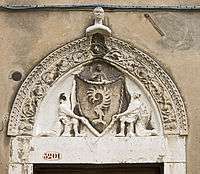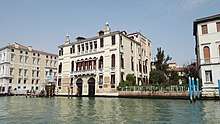Palazzo Malipiero
Palazzo Malipiero is a palace in Venice, Italy. It is located on the Grand Canal in the central Campo San Samuele. It stands just across from Palazzo Grassi Exhibition Center. The adjacent Italian-style garden with a view on the Grand Canal, a rarity in Venice, makes it even more distinctive. Initially built in a Byzantine style, over the centuries it has undergone some modifications.
.jpg)
History
The Ca' Grande (big palace) of Saint Samuel was probably built at the beginning of the 11th century by Soranzo family, which also built in that period, together with the Boldù family, the church of San Samuele facing the land-facade of the Palace. In the 13th century a third floor was added.
In the early days of the 15th century the Cappello family, one of the most energetic and industrious families of Venice, became owners of the Palace as a result of marriages with the Soranzos. The Cappello family used the palace's storehouses to house the newly discovered printing and publishing activity. In the mid-16th century this family enlarged the building and modified the Grand Canal facade to its present shape.
Around 1590 the Malipiero family became tenants of the Cappellos and Caterino Malipiero, within few years as from 1610, through the marriage with Elisabetta Cappello and further purchases, became owners of the whole edifice. Evidence of the very many restorations done by him are the date 1622 and the initials K.M. - for Caterino Malipiero- in an engraving placed over on the main door he built, giving access to the new large entrance of the Palace.
Around the year 1725, the Malipiero began restoration works that gave the palace today's homogeneous aspect. In the first half of the 19th century, with Venice in decline, the Palace suffered the same destiny as many other palaces of patrician families: being sold to many successive owners. These transfers accelerated the structural deterioration until the Barnabò family purchased it. In 1951 the Barnabòs undertook a substantial restoration, returning the palace to a grand and serene eighteenth-century style. In 1948 died in Palazzo Malipiero the Venetian contemporary composer Ermanno Wolf-Ferrari.

Architecture

As with most Venetian palaces, the Cà Grande (Great House) of Saint Samuel is built as two main superposed floors, but unlike other palaces, each floor is accessed by its own independent entrance hall, stairway and porta d'acqua (water door).
Through an ancient Byzantine door one accesses the "secondo piano nobile" (second main floor). The main door opens onto a large 17th-century entrance hall leading to the magnificent "primo piano nobile" (first main floor) and to the ancient medieval courtyard, the 19th-century garden and the door on the Grand Canal.
The architectural development of the "Cà Grande di San Samuele" is similar to the traditional evolution of many Venetian palaces, the freedom and the harmony of structures underpinning the vivid rhythms and original fascination of the city. In fact the structure of the building is made of three parts, each closely merged to the others, representing three eras: the Byzantine style, the International Gothic style and the seventeenth century one.
The original part of the building was probably built between the 10th and 11th centuries by Soranzo family in Venetian-Byzantine style, as evidenced by the large door (number 3201) and the quadruple windows with round arches (later amalgamated into the gothic structure) visible on the San Samuele side. In the middle of the 14th century, the Soranzo added the third floor (the second main floor) to the Cà Grande, as evidenced by the pointed arch windows.
This Gothic design was perfectly amalgamated with the floor below, respecting and incorporating elements of the older construction. By the mid-15th century the Cappello decided to expand the narrow palace. Building on an unused area on the garden's side, the facade on the Grand Canal was widened to the dimensions we see today.
Restoring and enlarging the building was also the main concern of Caterino Malipiero, as testified by the date 1622 engraved with the initials K.M. on the main door accessing the large Palace entrance. The family's coat-of-arms with cock's claws is also proudly sculpted there. In the second half of the seventeenth century, Palazzo Malipiero, its architecture ignoring Baroque, was one of the richest and most meaningful buildings in Venice.
The etching of the palace in 1718 by Luca Carlevarijs shows the palace ended after the two main entrances and a Calle borders its back end and separates it from the other houses that now are part of the building. The drawing clearly depicts further back the then-called Calle della Commedia. In the first half of 18th century the Malipiero family, according to a now lost architectural plan, decided to connect the palace with some houses abutting it on its rear, eliminating the Calle Malipiero that separated them. The facade on Campo San Samuele was extended backwards by 30 meters; the garden was widened to include part of a pre-existing Ramo Malipiero which bordered the Palace on the garden side, and a new perspective was created from the Palace's main entrance to the garden. In the early 1950s Marco Barnabò Sr gave the renovation project of the palace, its interior and to the garden to Nino Barbantini who was at the time Director of the Ca' Rezzonico museum of 18th-century Venice.
St. Samuel parish cultural life was revived after 1950 with the restoration and establishment of the Palazzo Grassi as a Cultural Center was established. Palazzo Malipiero now hosts the exhibition spaces of Studio d'Arte Barnabò Gallery and Il Tridente multimedia publishing house. From the 1997 Venice Biennale, the Palazzo Malipiero hosts the official Slovenian pavilion and from the 2011 the official Montenegro pavilion, which featured artist Marina Abramović, together with many other art exhibitions.
Garden

The garden of Palazzo Malipiero was created, together with many others, at the end of the eighteenth century, when the large palace gardens situated on the outskirts of the city disappeared because of residential and industrial development.
No doubt due to the particularities of the building plan, with a large entrance hall connecting Campo San Samuele to the courtyard, the garden's layout is most original: the area, compartmented by a simple design of hedge lines, extends along the building and is aligned both on the courtyard and the Grand Canal.
Thus the garden, when viewed from the Grand Canal, is divided in two symmetrical parts centred on a Hercule's Nymph fountain. The latter is also aligned with the 17th century entrance hall, so that a perspective view can be seen when entering the palace from the main door, through to the fountain a statue of Neptune inserted in the opposite garden wall.
In the garden has been placed the large well (originally in the inner courtyard) that, with the family coat-of-arms and the sculpted figures of the bride and bridegroom Elisabetta e Caterino, bear witness to the union between the Cappellos and the Malipieros.
From the end of 19th century, a number of statues have contributed to enrich the garden landscaping. The hedge, thanks to its intense colouring and precise pruning, conveys a further sophisticated touch to this precious garden.
Giacomo Casanova and the Malipiero Family
Between 1656 and 1676, as a result of the construction of two popular theatres, the neighborhood of the San Samuele parish acquired a more seedy reputation. This was also true for the palace. For some years after 1740, Giacomo Casanova lived in Palazzo Malipiero. In spite of his young age (he was just 15 years old), he began his successful social life in these very rooms. Giacomo had been born nearby on Calle della Commedia (later renamed Calle Malipiero), and as a confidant of Senator Alvise Gasparo Malipiero (Alvise II "Gasparo" Malipiero in Italian), he began frequenting the palace.
Here he established relationships with some influential persons and with a great many ladies. But one day the Senator caught him with Teresa Imer, whom the Senator desired for himself, and Casanova was expelled from the Palace, and subsequently Venice. Casanova left a lively portrait of Alvise Gasparo in his Memoires. The latter work depicts the Venetian customs in the 18th century. Amid this age of the decadence, when Venice became a destination for gamblers, prostitutes, and patrons, the fortunes of the Malipiero also suffered and finally by the 1770 the family extinguished.
See also
- List of architecture monuments of Venice
- Palazzo Malipiero-Trevisan
Bibliography
- Giovanni Dolcetti a cura di Alvise De Michelis, Le vicende storiche dell'antico Palazzo Soranzo (poi Cappello, Malipiero e Barnabò) a S. Samuele, Venezia 2007.
- Maria Cunico, Il giardino veneziano: la storia, l`architettura, la botanica, Venezia 1989.
- Elena Bassi, Palazzi di Venezia, Venezia 1976.
- Gino Damerini, La Ca` Grande dei Cappello e dei Malipiero di San Samuele ora Barnabò, Venezia 1962.
- Giuseppe Lorenzetti, Venezia e il suo estuario, guida storico-artistica, Venezia 1926.
- Giacomo Casanova, Histoire de ma vie. (pubblicate postume, 1822–28).